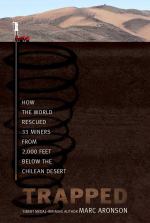
|
| Name: _________________________ | Period: ___________________ |
This test consists of 15 multiple choice questions and 5 short answer questions.
Multiple Choice Questions
1. In Chapter Six: August 10-21: “Drilling Blind,” what is the primary challenge faced by Kelvin Brown when drilling to reach the miners?
(a) Inaccurate maps and maps that have not been updated.
(b) A lack of drilling equipment.
(c) Resistance from the miners.
(d) A lack of drilling expertise.
2. In Chapter Three: "The Men of Hephaistos," which mine is mentioned in the chapter as an example of a place where men seek work in the desert?
(a) Candelaria Mine.
(b) San José Mine.
(c) Sterling Hill Mine.
(d) Potosí Mine.
3. In Chapter Four: August 5–8: “Murderers,” what emotions fluctuate among the miners as they grapple with their predicament?
(a) Despair and rage.
(b) Joy and anticipation.
(c) Relief and optimism.
(d) Confusion and indifference.
4. In Chapter Four: August 5–8: “Murderers,” what is the main concern of the rescue crew upon returning from the mine?
(a) Determining the cause of the collapse.
(b) Gathering information about the miners.
(c) Assessing the condition of the mine shaft.
(d) Providing immediate medical assistance.
5. In Chapter Two: "Of Earth and Cold," what geological event occurred around 40 million years ago?
(a) Earthquake.
(b) Continental collision.
(c) Volcanic eruption.
(d) Meteor impact.
6. In Chapter Four: August 5–8: “Murderers,” what unites the trapped miners and helps maintain a sense of collective purpose?
(a) A shared belief in the government's rescue efforts.
(b) A commitment to democracy and voting on decisions.
(c) A desire to escape at any cost.
(d) A common fear of darkness and isolation.
7. In Chapter Three: "The Men of Hephaistos," what does the name "Copiapó" (33) mean, and how is it related to the town's history?
(a) Place of Exploration, emphasizing its role as a hub for adventurers.
(b) City of Mines, signifying its mining heritage.
(c) City of Festivals, highlighting its cultural celebrations.
(d) Land of Plenty, symbolizing its agricultural prosperity.
8. In Chapter Six: August 10-21: “Drilling Blind,” what does Kelvin Brown describe as the prevailing mood among the families at the campsite?
(a) Angry and confrontational.
(b) Joyful and celebratory.
(c) Hesitant and doubtful.
(d) Sad, somber, and filled with despair.
9. In Chapter Six: August 10-21: “Drilling Blind,” what is the timeline for the trapped miners' survival, as mentioned in the chapter?
(a) 1 month.
(b) 10 days.
(c) 4 weeks.
(d) 2 weeks.
10. In Chapter Two: "Of Earth and Cold," which geological feature along the Pacific coast of South America resulted from the collision of the Nazca Plate against the continent?
(a) The Rocky Mountains.
(b) The Amazon River.
(c) The Andes Mountains.
(d) The Sahara Desert.
11. In Chapter Two: "Of Earth and Cold," how did the cooling effect from the Himalayas potentially relate to the formation of ice caps at the poles?
(a) Ice caps were formed due to volcanic activity.
(b) The cooling effect prevented ice caps from forming.
(c) It is unrelated to ice cap formation.
(d) The cooling effect likely contributed to ice cap formation.
12. In Chapter Two: "Of Earth and Cold," what impact did the Himalayas have on carbon dioxide levels in the atmosphere?
(a) They caused an increase in carbon dioxide levels.
(b) They released carbon dioxide into the atmosphere.
(c) They had no effect on carbon dioxide levels.
(d) They absorbed carbon dioxide, leading to a cooling effect.
13. In Chapter Three: "The Men of Hephaistos," how do mine owners and bosses respond when miners express concerns about working conditions in the San José Mine?
(a) They ignore the concerns and urge miners to keep working.
(b) They shut down the mine permanently.
(c) They offer higher wages to the miners.
(d) They improve safety measures immediately.
14. In Chapter Five: August 8–10: “Hope,” who is tasked with evaluating rescue strategies?
(a) Bishop Quintana.
(b) Luis Urzúa.
(c) Fidel Baez.
(d) Kelvin Brown.
15. In Chapter Six: August 10-21: “Drilling Blind,” what is Kelvin Brown's mission at the San José mine?
(a) To supervise rescue operations.
(b) To guide a drill to reach the trapped miners.
(c) To provide emotional support to the families.
(d) To extract valuable minerals.
Short Answer Questions
1. In Chapter Five: August 8–10: “Hope,” how does the chapter describe hope in the context of faith?
2. In Chapter Four: August 5–8: “Murderers,” what is the primary goal the miners work toward together during their ordeal?
3. In Chapter Three: "The Men of Hephaistos," how does the advent of the Age of Electricity impact the demand for copper?
4. In Chapter One: "August 5-6," what is the first alarming event that Raul Villegas experiences while driving in the mine?
5. In Chapter One: "August 5-6," when Villegas reports the unusual events to his bosses, how do they initially react?
|
This section contains 813 words (approx. 3 pages at 300 words per page) |

|




